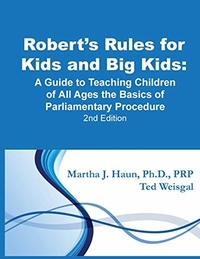Let’s teach our kids Robert’s Rules!

Scenario #1
Through Tee Ball, an introduction to Little League®, 4–7-year-olds begin learning baseball. Children are properly outfitted with helmets, bats, balls, and gloves. Each stage of learning involves drills.
Scenario #2
A student becomes an officer. They attend a meeting. After formalities like roll call, someone, floundering, says, “I motion that…” Someone else says, “I second that.” Students interrupt and talk over each other. Chaos ensues. These individuals haven’t been trained.
Both scenarios are realistic. We live in challenging times. We devote more attention to learning sports than to developing democratic institutions.
This need not be the norm. Finally, Dr. Martha Haun and I have written Robert’s Rules for Kids and Big Kids: A Guide to Teaching Children of All Ages the Basics of Parliamentary Procedure.
Advancing democracy justifies the teaching of Robert’s Rules from an early age. In addition, students, starting in kindergarten, also enhance their reading and critical thinking skills, developing self-awareness, self-management, social awareness, relationship skills, and responsible decision-making. They love games and through this game of Robert’s Rules, learning begins.
Download table of contents here
Throughout society, bad meetings are common. People attend one and say, “never again.” In learning this material, the seeds for a more engaged democratic society are planted.
The inspiration for this book came when I saw a girl wearing a beautiful red skirt over a crinoline petticoat with unmatching rainbow-colored knee socks. I asked the mother, “Who dressed your daughter?” “She did!” “How old is she?” “Four.” If a four-year-old can construct such an ensemble, all kids can learn the simple rules of good meetings and how Robert’s Rules makes meetings effective.
Teach kids Robert’s Rules in high school
Seasoned educator Wayne Jennings describes in School Transformation the introduction of Robert’s Rules to his high school class. For the final project, students demonstrated their skill. The principal said he was going to drop in for a few minutes. Entranced, he observed for the full two hours. Jennings has endorsed Robert’s Rules for Kids and Big Kids.
Democracy, manifested in Robert’s Rules of Order, helps solve problems building on the diverse talents of the group. It’s why this ancient concept survives. Robert’s Rules of Order plays a major role within organization boards, civic bodies, church councils, and union boards, but too often it is not used properly. Robert’s Rules, played properly, serves a significant role in solving the world’s problems. The time to teach it to every student is now.
This book empowers you to teach kids Robert’s Rules
Our book, Robert’s Rules for Kids and Big Kids: A Guide to Teaching Children of All Ages the Basics of Parliamentary Procedure, will provide the tools you need for your kids to learn this subject. Sceptical? Take a look at the table of contents to see how the program progresses. Your students can master this material and will reap personal benefits when they use it in the future—as will our society.
- Download the table of contents here.
- Purchase this book on Amazon.com here.
- Download PDF of this article here.
© Ted Weisgal 2021. All rights reserved.

Martha Haun, PhD, Professional Registered Parliamentarian

Ted Weisgal, member, National Association of Parliamentarians


I attempted to get the book via Kindle – I really didn’t want a $20 book on my shelf, and thought a $3 electronic version would be sufficient. Unfortunately, the Kindle version is impossible to read on an iPad. Supposedly 41 “locations” in the book, but locations 20-37 – where most of the text apparently is – aren’t accessible. And only a couple more pages on my iPhone which were too small to read. Please don’t waste $3 on the Kindle version – there’s apparently no way to get a refund.
Ray, thanks for letting us know. Sorry to hear this.